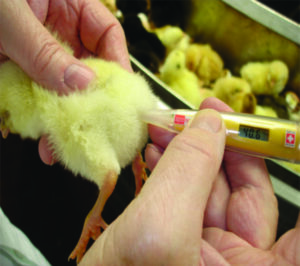Successful brooding practices are key to achieving profitable broiler production and assuring the welfare of the flock, writes Nigel Strain, Senior Regional Manager, Tech Service EMEA, at Cobb
Proper brooding is essential for early development and growth, flock uniformity, health and efficiency. There is a clear correlation between first week performance and final performance metrics.
An optimal 7-day brooding period can produce a commercial broiler with higher average daily gain and lower feed conversion ratio, as good early development helps produce a more efficient broiler. A minimum growth ratio of 4.6 should be achieved in the first week. This can be accomplished through rigorous attention to detail, providing a comfortable stress-free environment, and easy access to good quality water and feed.
Providing the correct temperature is crucial during early brooding. Because the chicks do not become homeothermic until at least day five, they are dependent on supplemental heat to achieve the proper temperature. Preheating the house requires at least 28◦C for the concrete and a floor temperature of 30◦C before the chicks arrive.
A comfortable internal body temperature of 40-40.6◦C needs to be maintained during the first four days, increasing to 41-42◦C thereafter. When setting house brooding temperature, one must consider the interaction with relative humidity. High relative humidity will be uncomfortable for the chicks, impair their heat loss, and also add excess moisture to the litter. It is recommended that the relative humidity be maintained below 70%.
Managing air quality
Air quality should be managed at all times. An optimised ventilation system will remove noxious gases and excess moisture from the house and provide an optimal supply of oxygen (at least 19.6%). High carbon dioxide level will result in lethargic, inactive chicks with reduced consumption and growth, affecting performance. The carbon dioxide level should never exceed 3,000 parts per million (0.3%).
Once a chick has consumed water and feed, development and growth will start. However, if early feed consumption is not achieved both the fat and the protein contained in the yolk will be depleted and leave inadequate protein levels for development and growth.
To provide each chick with ease of access, and aid uniformity, we recommend placing a row of good quality paper on each side of the drinker lines and a minimum of 75g of feed per chick evenly distributed on the papers. The feed on the papers needs to last approximately 72 hours, until all the chicks can access the main feeder source.
Clean water
Water quality and management is vitally important. Simply put: If the water is not good enough for human consumption, then it is not fit for our broilers. Keeping water lines clean during brooding requires consistent attention because the warm environment and slow flow of water through the drinker lines provide ideal conditions for bacterial growth.
Flushing drinker lines regularly will prevent biofilm build-up and help maintain drinking water temperature below 25◦C. For a high-flow drinker system, we recommend a flow rate through nipples of 40ml per minute during the first seven days.
A flow higher than 40ml per minute makes it difficult for the chicks to activate the nipples and can also result in more spillage creating wet litter. As a rule of thumb, in the first 24-hours post placement each chick should be consuming the equivalent of half its bodyweight in water (approximately 1ml per hour) and a quarter of its bodyweight in feed.
Supporting weaker chicks
Every placement will have some percentage of weaker, slower-eating chicks. Supporting and allowing them to catch up with their faster-eating peers will promote better uniformity. To accomplish uniformity of chick growth and development, provide easy access to water and feed and regularly evaluate consumption during early brooding by checking water meter readings and performing crop-fill checks. The first 8 hours after placement, 85% of chicks should have feed and water present in their crop and this should increase to 95% after 24 hours.
The brooding area needs to be bright, ideally at least 40 lux, to encourage good activity and alertness. Light distribution should be even across the barn by avoiding particularly bright or shaded areas. The darkest brooding area should be a minimum of 25 lux and no more than 20% variance between the brightest and darkest part of the brooding area.
Optimising brooding will unlock the genetic potential of the broiler – proper management of feed, air, water, light and temperature are crucial factors for ideal bird performance. This extra effort during the brooding phase will be rewarded in the final flock performance.



